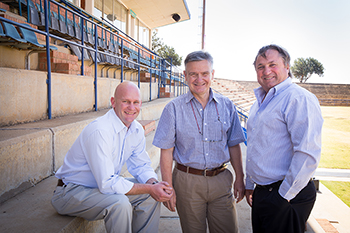
The study by Riaan Schoeman, (left), Prof Robert Schall,
and Prof Derik Coetzee from the University of the Free State
on variables in Super Rugby can provide coaches with
insight on how to approach the game.
Photo: Anja Aucamp
It is better for Super Rugby teams not to have the ball, which also leads to reduced overall playing time in matches.
This observation is from a study by the University of the Free State on the difference between winning and losing teams. Statistics between 2011 and 2015 show that Super Rugby winning teams kick more and their defence is better.
These statistics were applied by Riaan Schoeman, lecturer in Exercise and Sport Sciences, Prof Derik Coetzee, Head of Department: Exercise and Sport Sciences, and Prof Robert Schall, Department of Mathematics and Actuarial Sciences. The purpose of the study, Changes in match variables for winning and losing teams in Super Rugby from 2011 to 2015, was to observe changes. Data on 30 games (four from each team) per season, supplied by the Cheetahs via Verusco TryMaker Pro, were used.
About two minutes less action
“We found that the playing time has decreased. This is the time the ball is in play during 80 minutes,” says Schoeman. In 2011, the average playing time was 34.12 minutes and in 2015 it was 31.95.
“The winning team has less possession of the ball and doesn’t want it. They play more conservatively. They dominate with kicks and then they play,” says Prof Coetzee, who was the conditioning coach for the Springboks in 2007 when they won the World Cup.
Lineouts also more about kicking
As a result, the number of line-outs also increased (from 0.31 per minute in 2011 to 0.34 in 2015) and the winning teams are better in this regard.
“The winning team has less possession of the ball
and doesn’t want it. They play a more conservative
game. They dominate with kicks and then they play.”
Schoeman believes that rule changes could also have contributed to reduced playing time, since something like scrum work nowadays causes more problems. “When a scrum falls, the time thereafter is not playing time.”
According to Prof Coetzee, rucks and mauls have also increased, (rucks from 2.08 per minute in 2011 to 2.16 in 2015 and mauls from 0.07 per minute in 2011 to 0.10 in 2015). “The teams that win, dominate these areas,” he says.